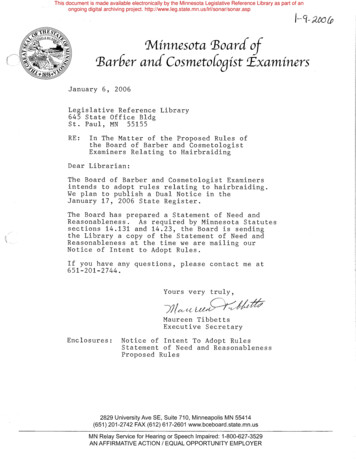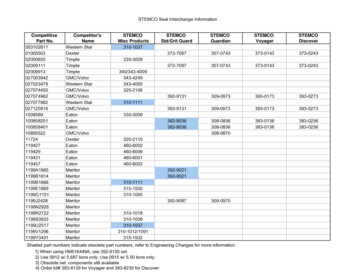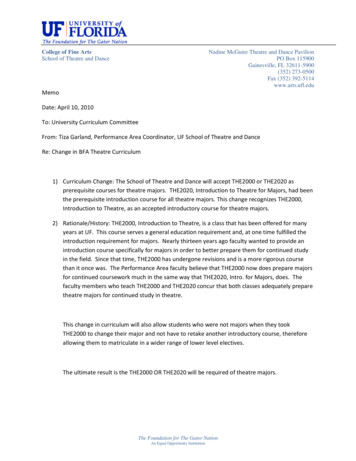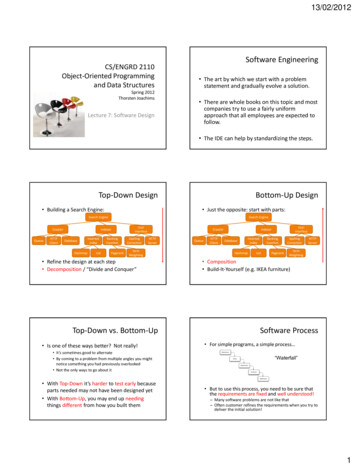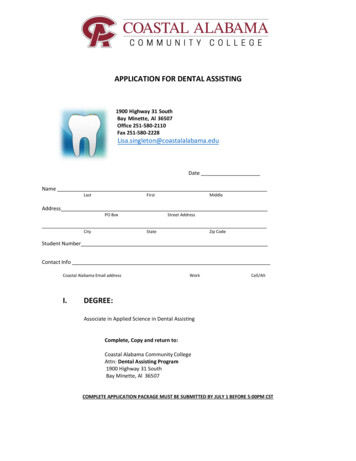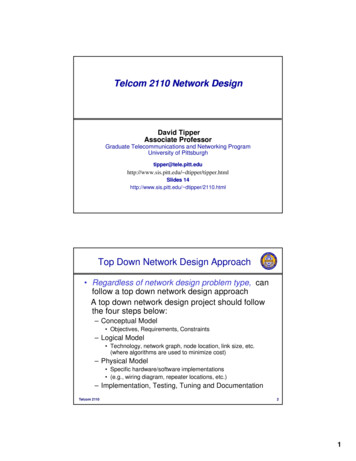
Transcription
Telcom 2110 Network DesignDavid TipperAssociate ProfessorGraduate Telecommunications and Networking ProgramUniversity of edu/ dtipper/tipper.htmlSlides 14http://www.sis.pitt.edu/ dtipper/2110.htmlTop Down Network Design Approach Regardless of network design problem type, canfollow a top down network design approachA topt downdnetworktk designd i projectj t shouldh ld ffollowllthe four steps below:– Conceptual Model Objectives, Requirements, Constraints– Logical Model Technology, network graph, node location, link size, etc.(where algorithms are used to minimize cost)– Physical Model Specific hardware/software implementations (e.g., wiring diagram, repeater locations, etc.)– Implementation, Testing, Tuning and DocumentationTelcom 211021
Request for Proposals (RFPs) Many organizations develop a Request forProposal (RFP) before making large networkpurchases or services RFP intended to create a competitiveenvironment for providing network equipmentand/or services Once vendors/consultants have submittednetwork proposals, the organization evaluatesthem against specific criteria and selects thewinner(s) No fixed format for RFPs across allindustries/organizations – many templatesavailable for specific scenarios on the web May need to write/develop an RFP or aresponse to an RFPRFP Components If writing an RFP some standard components Background Information– Organizational profile;– Overview of current network/system and services;– Goals of the network design Network Requirements– Choice sets of possible network designs (hardware, software); Mandatory, desirable, and wish list items– Security and control requirements– Throughput,Thh t RResponse titime, lloss andd availabilityil bilit requirementsit(i.e., performance and reliability guarantees)– Vendor constraints– Guidelines for proposing network designs– Intent is to scope out the design requirements to the best of yourknowledge2
RFP Components Service Requirements– Continuity of services– Implementation timeline plan– Support service needs For example, spare parts on site , on-call service support, training on use andmanagement– Workforce requirements Bidding Process– Time schedule for the bidding process;– Ground rules and bid evaluation criteria;– Availability of additional information and mechanism to ask and respond toquestions Information Required from Proposer– Corporate profile;– Experience with similar projects; Reference list Formatting requirements.– Page limit or fixed format structure to RFP– Who will evaluate responses and how much time is allocated for it?Responding to an RFP If RFP has strict format be sure to follow the exactformat that the RFP specifies. If no fixed format, write a sales design document– Describe your customer’s requirements and howyour design meets those requirements Presenting the design with focus on:– Organizational needs– Business objectives– Best practices– Document the budget for the project– Explain plans for implementing the design Goal is to Sell the proposal to reviewers3
Typical RFP Response Topics A network topology for the new design Information on the protocols, technologies, andproducts that form the design An implementation plan A training plan Support and service information Prices and payment options Qualifications of the responding company Recommendations from other customers Legal contractual terms and conditionsTypical RFP Response Format Executive summaryProject goalProject scope and servicesDesign requirementsNew logical and physical designImplementation plan including testingProject budgetAppendices with various details4
Design Requirements Following Top Down Network Design method – partitioninto business and technical Business goals/requirements explain the role the networkdesign will play in helping the organization succeed– Be creative – this is a sales pitch– What services can be offered in addition to therequirements in RFP Technical goals:– How does network meet goals in RFP and some notmentioned– scalability, performance, security, manageability,usability, adaptability, and affordabilityLogical and Physical Design Logical design– Topologyp gy– Models for addressing and naming– Switching and routing protocols– Security strategies– Network management strategies, includingpossible staffing needs Physical design– Actual technologies and devices includingvendor and software5
Implementation Plan Recommendations for deploying the networkdesign Project schedulesched le– Including any dates and times for service providerinstallations Any plans for outsourcing Training RisksRi k MManagementt strategyt t– A fallback plan if the implementation should fail– A plan for evolving the design as new requirementsarisePossible Appendixes Detailed topology mapsDevice configurationsAddressing and naming detailsNetwork design testing results (e.g.,simulations) Pricing and payment options More information about the company that ispresenting the design– Annual reports, product catalogs, press releases Legal contractual terms and conditions6
Course Review Introduction– Network design categories– TopTop-downdown design method Requirements and Planning– Technical Goals and Constraints Availability calculations, performance models– Traffic Demand Estimations– Project Costing NetworkNkDDesigni ModelingM d liandd AlAlgorithmsih– Relevant Results from Graph Theory Basic graph analysis Tree Design (MST, SPT, Prim-Dikijistra Trees) Ring Design (nearest neighbor, multi-ring)Telcom 211013Course Review Network Design Modeling and Algorithms– Relevant Results from Optimization Theory Linear Programming– Formulation, Solution, Simplex Method, Software Tools Integer Linear Programming– Branch and Bound Method Network Design Models– Arc flow formulation, path formulation Access Network Design– Topology algorithms One speed one center design (CMST – EW or Sharma algorithms) Multi-speed one center (Cahn’s MSLA) Mult-center Design (NNEW, MCEW)– Wireless access network designTelcom 2110 Point to Point, Last Hop design147
Review Metro Network Design– Mentor, Mentour Algorithms,goptimization based approaches Wide Area Network Design– Design Algorithms (IP/MPLS/WDM)– Capacity Assignment for packet services Min Delay, Min Max Delay, etc.– Virtual network design in MPLS– Network Survivability Rings, Link protection, path protection , p-cycles– WDM network Design RWA, Survivability, Traffic GroomingTelcom 211015Summary Network Design is not a precise science.– Many different types of problems e.g.,e g greenfield vsvs. incremental,incremental wired vsvs. wireless– There can be several good answers (many more badones!) - usually no one best solution.– It involves trade-offs among cost vs. performance,technical vs. non-technical issues Top Down Design approach useful as a framework In many network designs (WAN(WAN, Metro) usemathematics/algorithms to help designers identifygood solutions– Use computer models to solve mathematicalformulations when possibleTelcom 2110168
Many organizations develop a Request for Proposal (RFP) before making large network purchases or services RFP intended to create a competitive environment for providing network equipment and/or services Once vendors/consultants have submitted network proposals, the organization evaluates them against specific criteria and selects the
